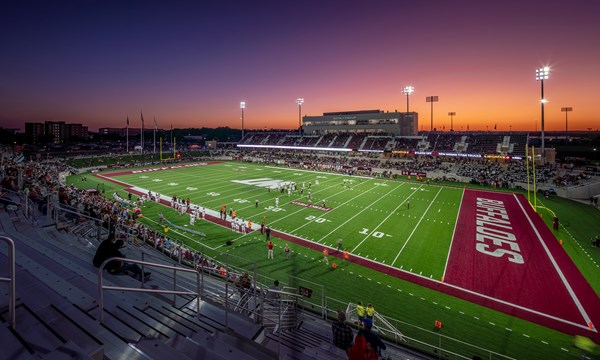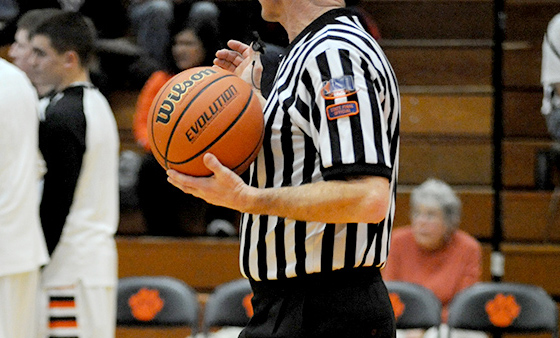West Texas A&M Scores Big with Buffalo Stadium
After nearly six decades of playing football nearly two miles down the road from campus at Kimbrough Stadium, the West Texas A&M University football program finally moved back on campus for the fall of 2019 into brand-new Buffalo Stadium in Canyon, Texas.
The 8,500-seat facility, which can accommodate a crowd of up to 12,000 with standing room, is a facility which Kent Johnson, Associate Athletic Director of Facilities at the school, said is one of, if not the most “modern and beautiful football stadiums possibly in Texas and certainly at the NCAA Division II level.
 “You’d be hard-pressed to find someone who’d say the school made the wrong decision to bring football on campus,” Johnson said.
“You’d be hard-pressed to find someone who’d say the school made the wrong decision to bring football on campus,” Johnson said.
The project, which was part of a $44 million investment in athletics at the school’s Buffalo Sports Complex, was overseen by the DLR Group, the A&M University FP&C, and Western Builders, which utilized a number of subcontractors to make the field a reality. Both Dr. J. Patrick O’Brien, former president at WTAMU, as well as Dr. Walter V. Wendler, the school’s current president, were instrumental in their support of the project as well, Johnson said.
From locker rooms equipped with Bluetooth speakers, to ribbon boards and a massive Daktronics jumbotron along the north end zone, to a press box facility modeled after those found at larger institutions, every single person who partakes in the game day experience at Buffalo Stadium has the ability to take advantage of the state-of-the-art confines.
Plus, the team no longer has to take a bus to its home games.
“It’s a Division I-caliber stadium,” said WTAMU coach Hunter Hughes, the fourth-year head coach at the school who spent time as a graduate assistant at both Colorado and Tennessee. “I compare it to Texas or Texas Tech. They seat 80-100,000; this is just one-tenth of the size, but it has all the bells and whistles that those Division I stadiums have.”
The jumbotron, the largest of its kind in the Lone Star Conference, served as a rotating billboard commemorating WTAMU graduates in December after commencement was held virtually due to the coronavirus pandemic.
The press box tower features two radio booths, as well as a TV booth with a control room. The visiting athletic director gets their own box adjacent to the tower, too.
On the lower level of the press box tower is the Fairly Club, a spot for boosters, donors, and friends of the school to congregate before, during, and after games. The Fairly Club has also become integral to the recruiting process.
 “We use it for recruiting dinners for all sports,” Johnson said. “We’ve got organizations and departments on campus that when they need to have a meeting facility above and beyond a classroom atmosphere, they can go over there because we’ve got the technology in it.”
“We use it for recruiting dinners for all sports,” Johnson said. “We’ve got organizations and departments on campus that when they need to have a meeting facility above and beyond a classroom atmosphere, they can go over there because we’ve got the technology in it.”
Whether tied directly to the stadium or not, enrollment at WTAMU reached a record level in 2019 with some 10,250 students, up from 7,200 when Johnson began in his role in 2008 – an increase of nearly 43 percent.
While Kimbrough Stadium seats nearly twice the amount of Buffalo Stadium, it was a multi-use facility that included a track around the field, creating separation between the fans and the players.
Now, the stands – not to mention two levels of suites complete with all sorts of modern amenities – are right on top of the action.
» ALSO SEE: Fundraising Amid the COVID-19 Pandemic
The intimacy between players and fans exists before the game like never before, too, as the football team completes its walk through the tailgating lot from its locker room, located about 200 yards away from the stadium itself, before each game.
“The stadium is one thing, but the atmosphere on campus that has come with the stadium on game day has exploded, I believe,” Hughes said.
One of the biggest holdovers from Kimbrough to Buffalo Stadium is the uniquely Texas sightlines, helped by the fact that the playing surface is roughly 15 feet below ground level. Johnson said that was one of the biggest sticking points with students and fans, keeping the visual aspect of the stadium the same.
“That stadium was just a void that was missing,” said Stan Peña, Director of Contracts and Projects at the school. “It created a connection that just didn’t exist.”




